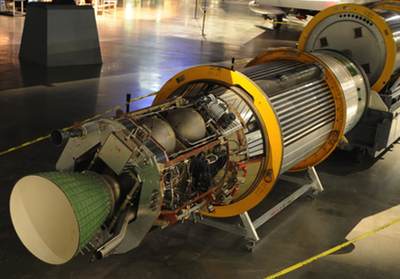Bit by precious BITby Dwayne A. Day
|
| One of the advantages of the Agena was that in addition to payloads on its nose, the aft rack could mount various secondary payloads, including engineering experiments and even deployable satellites. |
According to somebody who worked on it, the system consisted of an electronics “black box” mounted to the Agena upper stage rocket that placed CORONA reconnaissance satellites in orbit and provided power and stabilization to them during their short period of operation. By the early 1960s the Agena had evolved into a versatile space truck that carried many payloads. Occasionally it simply carried them into orbit, but often it supported them during their short lifetime orbiting the Earth—a few weeks at most. BIT was only installed on the CIA’s CORONA spacecraft, because the CIA owned them; it was not installed on other classified satellites like the GAMBIT, which was owned by the National Reconnaissance Office. According to a source, the CIA was “desperate” to get into the satellite signals intelligence business, and BIT was its first modest effort.
One of the advantages of the Agena was that in addition to payloads on its nose, the aft rack could mount various secondary payloads, including engineering experiments and even deployable satellites. This is where the BIT system was installed. One of the Lockheed engineers who worked on the system reported that decades later he was startled to see an Agena in a museum with the BIT box still attached, despite the fact that it was a highly classified piece of technology.
Some information on BIT can be gleaned from dozens of recently declassified cables apparently sent from Lockheed, possibly to CIA Headquarters, reporting on what BIT was detecting. BIT’s data was probably recorded with other spacecraft telemetry and then sent down when the satellite flew over a ground station.
The messages cover the period October 1964 to June 1965, on CORONA missions 86 to 96, with the BIT missions apparently receiving the designations 7051 to 7059. Other signals intelligence satellites apparently also received mission numbers starting with 7—7501 was the first CANYON communications intelligence satellite, 7601 was the first RHYOLITE satellite for intercepting Soviet missile telemetry, and 7701 was probably the first JUMPSEAT satellite, which intercepted anti-ballistic missile radar signals. The Air Force and Navy low Earth orbit signals intelligence satellites designed to intercept radar signals were probably in the 7101–7401 series.
| One of the few aspects of HEXAGON that remains classified was the secondary and deployed payloads that could be fitted to its forward structure. Perhaps one of them served the same purpose as BIT. |
The vast majority of the cables indicate that BIT detected nothing on its orbits around the Earth. One flight—CORONA 91, BIT Mission 7055—launched in mid-January 1965, apparently did detect an interesting signal that the ground station operators believed deserved greater attention. But what this was is unclear from the slim available data. Another mission apparently detected a Soviet Tall King air surveillance radar, although that was not BIT’s purpose. According to the engineer who worked on BIT, they detected a suspicious signal only once, when a CORONA spacecraft flew over Moscow. They later learned that there was an electronics research facility outside the city that might have been the source of the signal, but it is unknown if the CIA ever decided that this represented an actual threat to the spacecraft.
The records on BIT end in summer 1965 and it is unclear if the system was continued, although CORONA continued in operation until 1972. Certainly some kind of system for attempting to detect electronic attacks on a satellite would appear to be a requirement for national security spacecraft. Last fall, when CORONA’s replacement, the HEXAGON, was declassified, one of the few aspects of that program that remained classified was the secondary and deployed payloads that could be fitted to the HEXAGON’s forward structure. Perhaps one of them served the same purpose as BIT. What is known is that BIT operated during a lull in P-11 signals intelligence satellite launches. The P-11s were deployed from the Agena aft rack and were designed to detect Soviet radar signals. They were manufactured by Lockheed, and perhaps the CIA took advantage in that downtime to have the company switch from building P-11s to installing BIT units.
